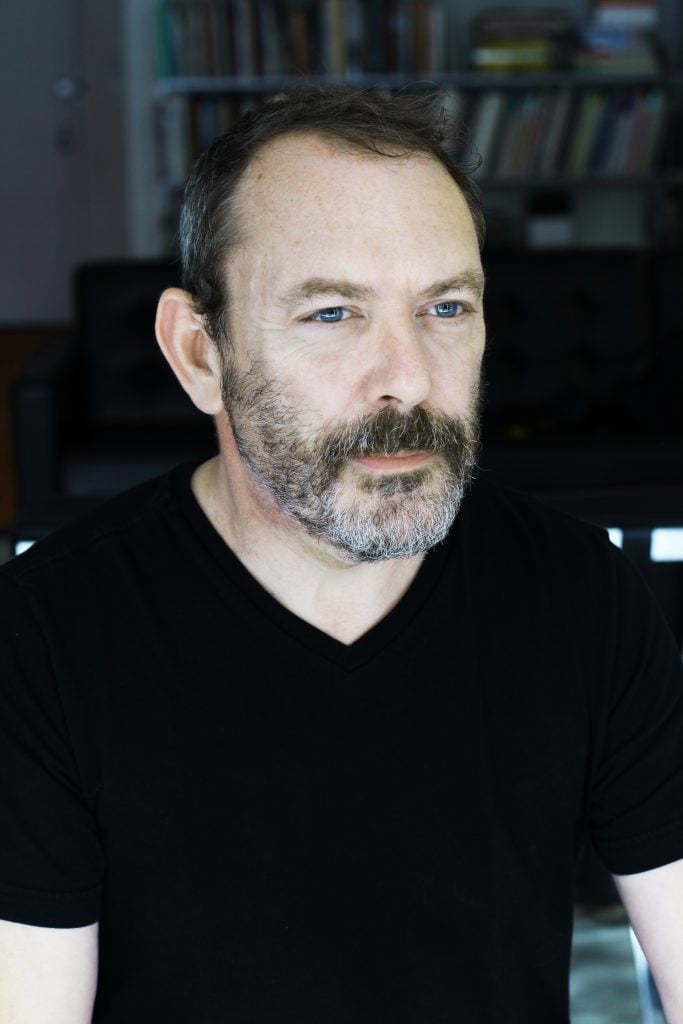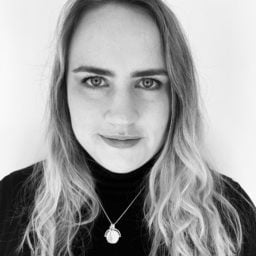In “Studio Visit,” artists invite us to peek inside their workspaces to offer insight into their process, inspirations, and obsessions.
The British-born artist Liam Gillick is usually based in New York, but this summer he is spending his time in Naples. The displacement hasn’t been hard for the artist who, for 30 years, has only needed a desk and computer for his studio.
Gillick came up alongside the YBAs in the 1990s and is best known today for his architectural and design interventions that prompt social responses from viewers as part of an effort to draw attention to systems of control that are embedded in our constructed world.
The artist has recently been hard at work on an upcoming show at Alfonso Artiaco gallery in Naples, titled “It should feel like unicorns are about to appear a.k.a. Half Awake Half Asleep,” which is slated to open on September 10.
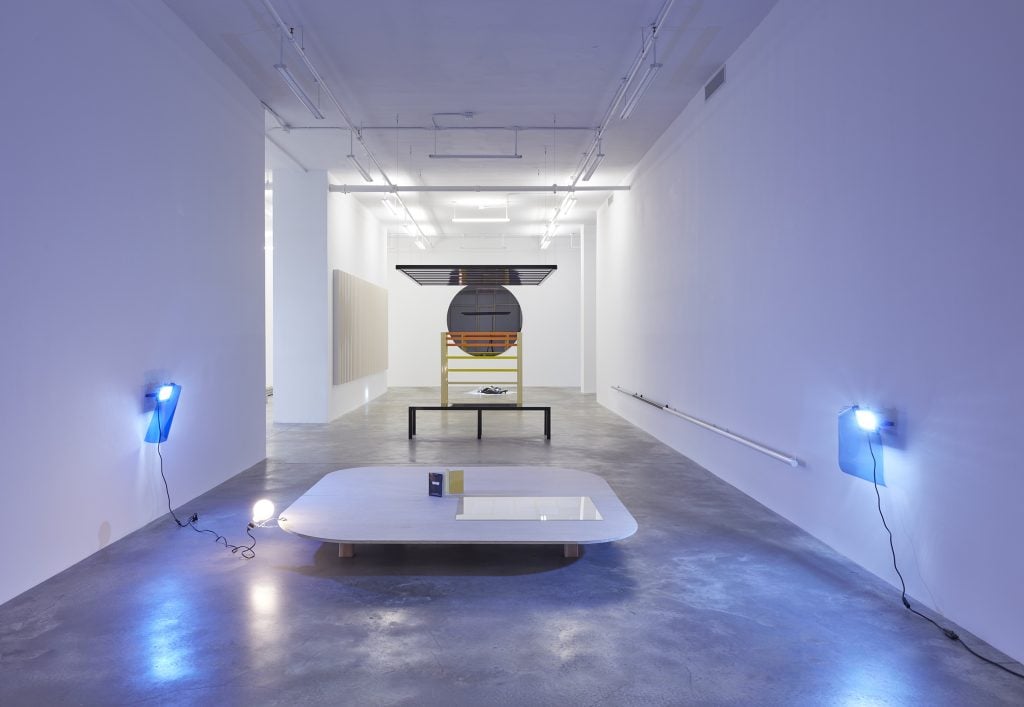
Installation view of “Liam Gillick: Redaction” at Casey Kaplan New York. ©Liam Gillick. Courtesy of the artist and Casey Kaplan, New York. Photo by Jason Wyche.
It will be the first opening Gillick will be able to attend in a while. A mini-retrospective of the artist’s career, “Redaction” at Casey Kaplan Gallery in New York, was open for just over a week before the city went into lockdown. In June, he had a show with Taro Nasu in Tokyo, which he couldn’t attend.
We caught up with Gillick to talk about what he’s listening to, how he is working, and his go-to creative lubricants.
What are the most indispensable items in your studio and why?
A fountain pen and propelling pencils. Hard drives. My notebook. An RAL color code book. A copy of [the graphics software] Blender 3D 2.82a. Various dongles and adaptors. Monitors of different sizes. Cameras of different resolutions. Piles of undifferentiated material samples. Piles of unsorted papers—for reassurance that there was a past and might be a future.
Is there a picture you can send of your work in progress?
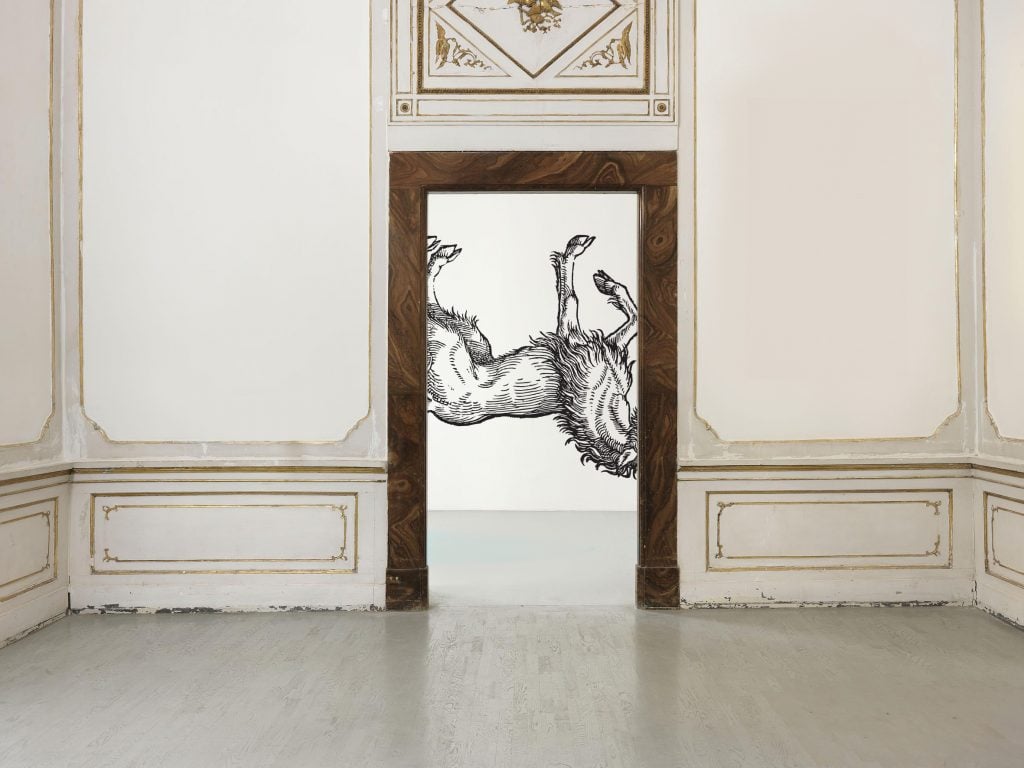
“Liam Gillick: It should feel like unicorns are about to appear a.k.a. Half Awake Half Asleep” at Alfonso Artiaco in Naples. Courtesy of the artist.
What is the studio task on your agenda tomorrow that you are most looking forward to?
I try and approach every day with no clear work agenda. My studio has always been a desk or table in a corner of my apartment—wherever that has been. I have worked this way for 30 years. I used to also clear my desk every evening so the next morning I could decide whether to continue the process of becoming an artist or not. It was a way to avoid just continuing what I was thinking about without thinking—if that makes any sense.
I don’t really like traditional studios. The contemporary studio tends to encourage a certain way of being in the world and a way of positioning the “studio visit” as a standard way of encountering art and artists. This article is the perfect form for a studio visit with me as I don’t do studio visits in reality. I am not even sure they are a humane way to corral artists.
Having said that, I do like to visit other people’s studios very occasionally. And of course I am often impressed and jealous. I have visited only one artist’s studio in the last year. To me it felt a like a set for an imaginary film about being a successful artist in New York in 2020. I think it even had a couple of cars parked in it.
I am more influenced by Lawrence Weiner and Joan Jonas, who essentially work at home and at the site of the exhibition itself. From the beginning I was a post-studio artist, using the exhibition itself as the site of the work. But now I accept that there is a location where I generally sit and think and work. My desk at home—or any temporary flat surface somewhere—is my studio. This has made the last few months a bit confusing. I spent more time than usual building virtual spaces on the computer so I could continue the process of thinking about exhibitions within a version of spaces themselves.
What kind of atmosphere do you prefer when you work? Do you listen to music or podcasts, or do you prefer silence? Why?
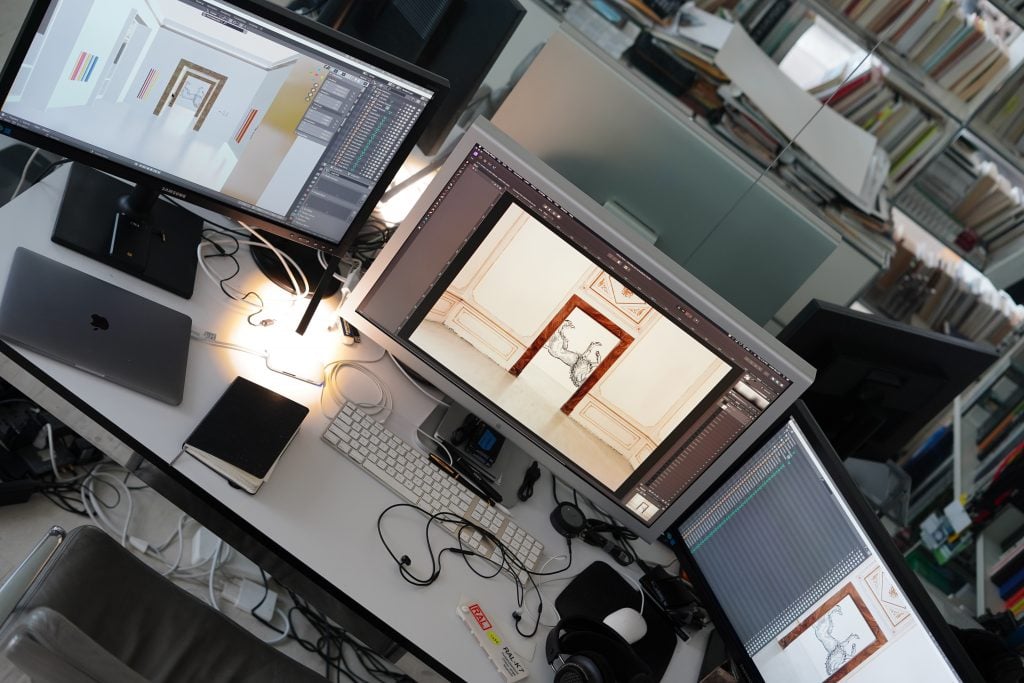
Liam Gillick’s studio in Naples. Courtesy of the artist.
When I am really productive I surround myself with external distraction. On an average day I have the radio on in the kitchen next door and the phone is usually playing podcasts or radio and often there are also CDs playing in the background across the room since I rebuilt my old CD player in April in energetic early lockdown repair mode. At the same time there are often YouTube clips of Blender3D tips playing simultaneously on one of the computers. To manage everything I have different sets of headphones for switching between various sources and a dedicated sound system running directly from the main computer itself. So I might be listening to something on the speakers, then switch between different sets of headphones for different reasons without having to turn off the music.
I can’t remember silence. I don’t really trust it. But it’s when I switch everything off that I know I have finished working. I need to hear conversations, discussions, and music while I work, as if creating something in a bar or semi-public situation but sitting at my desk at home. People talking over each other and music playing while I sit in the middle writing and drawing. I think this is because I am from the London suburbs and you had to learn to drown out the boredom with whatever you could get your hands on.
What trait do you most admire in a work of art? What trait do you most despise?
Admire: Difficulty, simplicity, complexity, intuition, subjectivity, and political testament executed with all the above.
Despise: I don’t really despise works of art, there are enough injustices in the world. Each artwork betrays its ideological underpinnings.
What snack food could your studio not function without?
Does espresso count as a snack?
Who are your favorite artists, curators, or other thinkers to follow on social media right now?
I read across media. I do not follow people and I do not look at art things any more than I look at economics or political theory. All journalistic media now generates stories out of social media posts or shows reactions. So I follow links and then move across to other links. I think this is related to early internet use in the 1990s when you had to go looking for things and they didn’t just arrive on your phone. I can’t break the habit. It means I do see what people end up posting but it is always because it relates to a more complex array of references.
When you feel stuck in the studio, what do you do to get un-stuck?
I go to Parnell’s Pub on 53rd Street and Second Avenue [in New York] and bring my notebook with me. Something usually happens after the second pint of Guinness.
What is the last exhibition you saw (virtual or otherwise) that made an impression on you?
Massimo de Carlo hosted an online exhibition of the gallery Fanta in Milan. They chose to show Noah Barker. “False Belief in the Stars” was a strikingly low key use of virtual space. The best work in it was titled Transparent. Open. Flexible. Crowded. User friendly. It’s a recording made in the first minute after the doors to the Centre Pompidou in Paris first opened in 1977. The title is a critique of emerging neoliberal cultural policy nine years after the uprisings of 1968. It’s an elusive work at first but it is important. Small gains made when great energy has been deployed can be turned inside out.
If you had to put together a mood board, what would be on it right now?
Floor wax. Dashi. Peter Saville. Naples. Pork Pies. Gin from Majorca. CS gas. Revel electric scooters. Legal documents towards the reorganization of art institutions. Startup checklists for Boeing 737s.
Follow Artnet News on Facebook:
Want to stay ahead of the art world? Subscribe to our newsletter to get the breaking news, eye-opening interviews, and incisive critical takes that drive the conversation forward.
